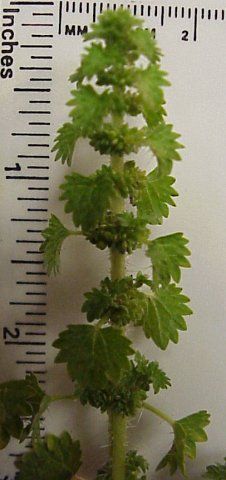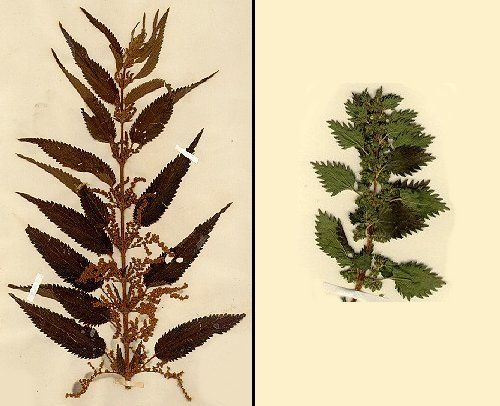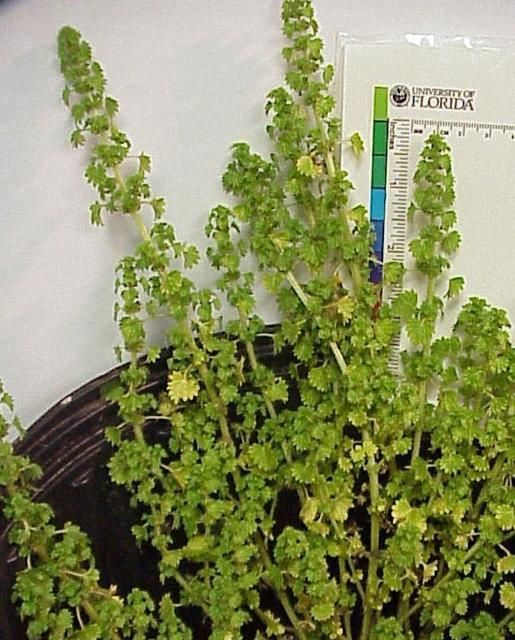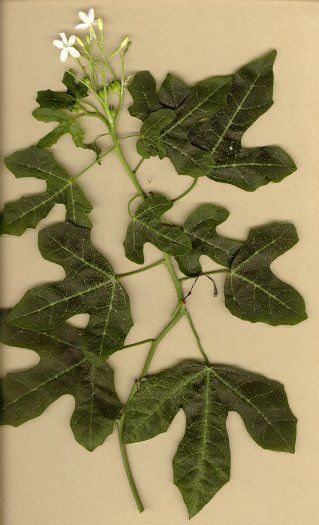Classification
Scientific Name: Urtica chamaedryoides Pursh
Common Name(s): heart-leaf nettle; weak nettle; fireweed; ortiguilla
Family: Urticaceae (nettle family)
Description
Annual herbs with stinging hairs.
Stems erect but weak and often supported by surrounding plants, generally 10–50+ cm (4–20+ in) tall, branching mainly from base.
Leaves opposite, triangular to heart-shaped in outline, bluntly and coarsely toothed, 1–6 cm (0.5–2.5 in) long, 1–4 cm (0.5–1.5 in) wide, reduced in size upward on stem, with linear bumps (cystoliths, concretions of calcium carbonate) on surface; leaf stalks (petioles) slender.
Flowers minute, unisexual (male and female in the same cluster), greenish; flower clusters more or less spherical and 3–6 mm (0.1–0.2 in) wide, axillary (arising from leaf stalk-stem junction).
Fruit tiny and seed-like (achene), 1 mm (0.04 in) long, flattened, egg-shaped in outline, brown, enclosed by bract-like structures (calyx lobes). See Figure 1.

Credit: Kent D. Perkins, UF Herbarium
Field Recognition Features. Weak-stemmed herbs with brittle, bulbous-based, fluid-filled, stinging hairs; opposite triangular leaves with scalloped-toothed margins; minute flowers in spherical clusters in leaf axils (Figure 2). It blooms from spring to summer in Florida.

Credit: Lawrence A. Halsey, UF/IFAS
Distribution. Florida: native; north and central peninsula, west to central panhandle. General: eastern and central United States, Mexico.
Habitat. Humus-rich soils (often over limestone) in floodplains, rich woods, and disturbed areas; common around farm yards.
Similar Species
Urtica dioica (stinging nettle, Figure 3: left, flowers in long compound clusters; native to Eurasia, reported from Alachua County), U. urens (burning nettle, dwarf nettle, Figure 3: right; flowers in elongate clusters; native to Europe; reported from Nassau, St. Johns, Lake, Orange, and Leon counties).

Credit: Kent D. Perkins, UF Herbarium
Toxicity
Irritant compounds (histamines, acetocholines, and serotonins) that cause reddening and intense itching fill the stiff, hypodermic-needle-like stinging hairs on the stem and leaves (Figure 4). When the tip of the brittle, tubular hair is broken, pressure on the bulbous hair base injects the irritants into the skin. The typical reaction, reddening and intense itching, is usually of short duration, although sensitive individuals may experience some swelling and burning. Washing the affected area or immediate application of baking soda paste soothes the stinging sensation for most people.

Credit: Lawrence A. Halsey, UF/IFAS
Economic Uses
None for this species. Related species of Urtica are used in herbal medicine and as an edible, spinach-like potherb (after boiling); extracts of the stinging compounds show promise as treatment for inflammatory conditions, such as arthritis.
Comments
The habit of U. chamaedryoides varies according to the environmental conditions: plants in shady areas tend to have longer, weaker stems with larger, more coarsely toothed leaves and looser flower clusters (Figure 1), while plants in more exposed areas are much smaller with more compact flower clusters (Figure 5).

Credit: Lawrence A. Halsey, UF/IFAS
The unrelated Cnidoscolus stimulosus (bull-nettle, stinging-nettle, tread-softly, finger-rot, Figure 6; Euphorbiaceae, spurge family), a common Florida plant, also has stinging hairs but is characterized by conspicuous white flowers and large, lobed leaves. A plant fact sheet for this species is also available.

Credit: Kent D. Perkins, UF Herbarium
Selected References
Miller, N. G. 1971. The Genera of Urticaceae in the Southeastern United States. J. Arnold Arbor. 52: 40–68.
Perkins, K. D. & W. W. Payne. 1981 [reprint]. Guide to the Poisonous and Irritant Plants of Florida. Circular 441. Gainesville: University of Florida Institute of Food and Agricultural Sciences.
Stern, L. J. 1943. Identification of Urtica [Nettle], Eleven Species. 13 pp. Post Institute, New York.
Woodland, D. W. 1989. Biology of Temperate Urticaceae (Nettle) Family. Pp. 309–318 in: P. R. Crane & S. Blackmore, eds., Evolution, Systematics, and Fossil History of the Hamamelidae, vol. 2., Clarendon Press, Oxford.
_____, I. J. Bassett, & C. W. Crompton. 1976. The Annual Species of Stinging Nettle (Hesperocnide and Urtica) in North America. Canad. J. Bot. 54: 374–373.
Wunderlin, R. P. & B.F. Hansen. 2011. Guide to Vascular Plants of Florida, 3rd edtion. University Press of Florida, Gainesville.
Zomlefer, W. B. 1994. Urticaceae, pp. 100–105. Guide to Flowering Plant Families. University of North Carolina Press, Chapel Hill.